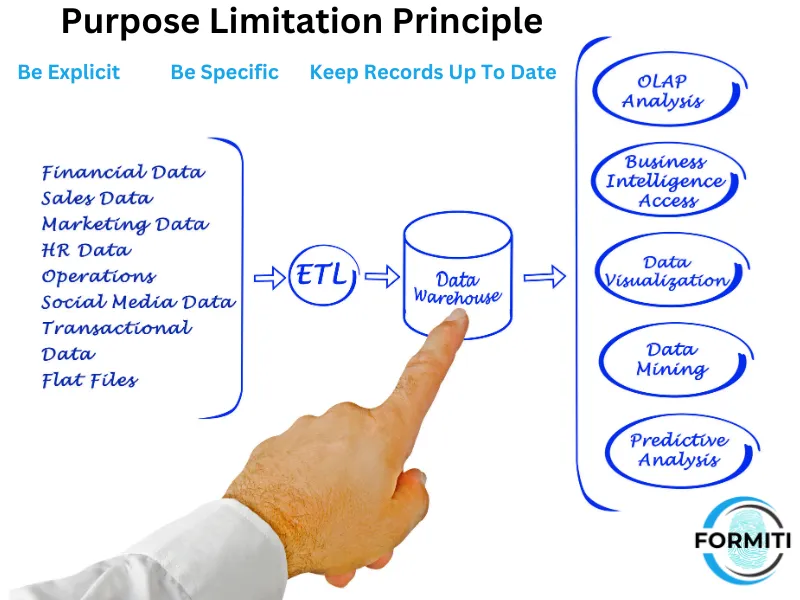Introduction
Personal information has become one of the most valuable commodities in today’s data-driven world. As a result, governments and organisations around the globe have introduced stringent data privacy regulations to protect the personal data of individuals. Among the core principles of these regulations is the Purpose Limitation Principle, a fundamental concept that plays a crucial role in safeguarding personal information.
This article will explore the Purpose Limitation Principle in Data Privacy, its definition, and its significance in data privacy regulations. We will also delve into the requirements for specifying purposes within a Record of Processing Activities (ROPA) and examine the rules for using personal data for new processing purposes.
Defining the Purpose Limitation Principle
The Purpose Limitation Principle, a cornerstone of any data privacy regulation , restricts how personal data can be processed. In essence, it dictates that personal data should be collected and processed for specified, explicit, and legitimate purposes and not further processed in a manner incompatible with those original purposes.
Why Data Controllers Need to Specify Their Purpose
Data controllers are entities responsible for determining the purposes and means of processing personal data. One might wonder why they must specify their purpose when processing personal data. The answer lies in protecting the rights and freedoms of individuals whose data is being processed.
- Protecting Individuals’ Rights: The purpose limitation principle is designed to safeguard individuals’ privacy and personal rights. By specifying the reasons for processing personal data, data controllers ensure that the data is used responsibly and does not infringe upon the individual’s rights.
- Transparency and Accountability: Clearly stating the purpose of data processing promotes transparency. It allows individuals to understand how their data will be used, enabling them to make informed decisions about sharing their information. This transparency is essential for building trust between individuals and organisations.
- Legal Compliance: Data privacy regulations mandate that organisations adhere to the purpose limitation principle. Non-compliance can result in severe penalties and legal consequences. Specifying purposes is a way for organisations to demonstrate their commitment to following the law.
Specifying Purposes within the Record of Processing Activities (ROPA)
To meet the requirements of the Purpose Limitation Principle, data controllers must state their purposes within each record in the Record of Processing Activities (ROPA). A ROPA is a document that records all data processing activities within an organisation. Here’s how they can do it:
- Be Explicit: Data controllers should clearly state the purpose for which personal data is collected and processed. Ambiguity should be avoided at all costs.
- Be Specific: The purpose description should be precise and tailored to the specific data processing activity. It should not be a generic statement that could cover a wide range of activities.
- Keep Records Up to Date: Data controllers must update the ROPA as new processing activities are initiated or if there are changes in the purpose of existing processing activities.
Rules for Using Data for Another Processing Purpose
While the Purpose Limitation Principle prohibits using personal data for purposes that are incompatible with the original ones, there are certain situations where new processing purposes may be allowed:
- Compatibility with the Original Purpose: If the new purpose is compatible with the original one, data controllers may proceed without specific consent. Compatibility generally means that the new purpose is related to the original one and can be reasonably expected by the data subject.
- Obtaining Specific Consent: Data controllers can use personal data for a new purpose if they obtain explicit and informed consent of the data subject. Permission should be freely given and easily revocable.
- Legal Provision in the Public Interest: Data controllers may proceed if an explicit legal provision requires or allows new processing for public interest purposes. This is often the case with public authorities that may need personal data for additional functions that serve the greater good.
Compatibility Assessments
If you’re considering a new purpose for processing personal data, you must conduct a compatibility assessment to determine whether this fresh objective aligns with your first one. This assessment should encompass several key considerations:
- Establishing Connections: Could you investigate any potential connections between your original purpose and the newly proposed one, looking for similarities or commonalities?
- Assessing Context: Delve into the context in which you originally acquired the personal data, focusing on your relationship with the individual in question and what they would reasonably anticipate regarding data usage.
- Analyzing Data Nature: Consider the nature of the personal data at hand, including whether it includes sensitive information that requires special handling.
- Gauging Impact: Assess the potential repercussions for individuals resulting from the new data processing activity, including any adverse effects or implications on their privacy and rights.
- Ensuring Safeguards: Verify whether appropriate safeguards, such as encryption or pseudonymisation, are in place to protect the data and mitigate potential risks associated with the new processing purpose.
Incorporating these factors into your compatibility assessment ensures that you make informed decisions when expanding the use of personal data while upholding privacy and data protection standards.
Conclusion
The Purpose Limitation Principle is a fundamental component of data privacy regulations, emphasising the importance of specifying and limiting the purposes for processing personal data. It is a critical element in ensuring that individuals’ rights and freedoms are protected while promoting transparency and accountability. Compliance with this principle and the rules for using data for new processing purposes ensure that personal information is used responsibly and in accordance with the law. As data plays an increasingly central role in our lives, the Purpose Limitation Principle remains a cornerstone in maintaining the balance between innovation and privacy.
